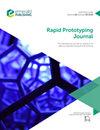Rapid prototyping of 3d printed micropillars using fused filament fabrication technique for biomedical applications
IF 3.6
4区 工程技术
Q1 ENGINEERING, MECHANICAL
引用次数: 1
Abstract
Purpose The hygroscopic properties of 3D-printed filaments and moisture absorption itself during the process result in dimensional inaccuracy, particularly for nozzle movement along the x-axis and for micro-scale features. In view of that, this study aims to analyze in depth the dimensional errors and deviations of the fused filament fabrication (FFF)/fused deposition modeling (FDM) 3D-printed micropillars (MPs) from the reference values. A detailed analysis into the variability in printed dimensions below 1 mm in width without any deformations in the printed shape of the designed features, for challenging filaments like polymethyl methacrylate (PMMA) has been done. The study also explores whether the printed shape retains the designed structure. Design/methodology/approach A reference model for MPs of width 800 µm and height 2,000 µm is selected to generate a g-code model after pre-processing of slicing and meshing parameters for 3D printing of micro-scale structure with defined boundaries. Three SETs, SET-A, SET-B and SET-C, for nozzle diameter of 0.2 mm, 0.25 mm and 0.3 mm, respectively, have been prepared. The SETs containing the MPs were fabricated with the spacing (S) of 2,000 µm, 3,200 µm and 4,000 µm along the print head x-axis. The MPs were measured by taking three consecutive measurements (top, bottom and middle) for the width and one for the height. Findings The prominent highlight of this study is the successful FFF/FDM 3D printing of thin features (<1mm) without any deformation. The mathematical analysis of the variance of the optical microscopy measurements concluded that printed dimensions for micropillar widths did not vary significantly, retaining more than 65% of the recording within the first standard deviation (SD) (±1 s). The minimum value of SD is obtained from the samples of SET-B, that is, 31.96 µm and 35.865 µm, for height and width, respectively. The %RE for SET-B samples is 5.09% for S = 2,000µm, 3.86% for S = 3,200µm and 1.09% for S = 4,000µm. The error percentage is so small that it could be easily compensated by redesigning. Research limitations/implications The study does not cover other 3D printing techniques of additive manufacturing like stereolithography, digital light processing and material jetting. Practical implications The presented study can be potentially implemented for the rapid prototyping of microfluidics mixer, bioseparator and lab-on-chip devices, both for membrane-free bioseparation based on microfiltration, plasma extraction from whole blood, size-selection trapping of unwanted blood cells, and also for membrane-based plasma extraction that requires supporting microstructures. Our developed process may prove to be far more economical than the other existing techniques for such applications. Originality/value For the first time, this work presents a comprehensive analysis of the fabrication of micropillars using FDM/FFF 3D printing and PMMA in filament form. The primary focus of the study is to minimize the dimensional inaccuracies in the 3D printed devices containing thin features, especially in the area of biomedical engineering, by delivering benefits from the choice of the parameters. Thus, on the basis of errors and deviations, a thorough comparison of the three SETs of the fabricated micropillars has been done.生物医学应用中使用熔丝制造技术的3d打印微柱的快速原型制作
3d打印长丝的吸湿特性和过程中的吸湿性导致尺寸不准确,特别是喷嘴沿x轴运动和微尺度特征。鉴于此,本研究旨在从参考值出发,深入分析熔丝制造(FFF)/熔丝沉积建模(FDM) 3d打印微柱(MPs)的尺寸误差和偏差。对于具有挑战性的长丝,如聚甲基丙烯酸甲酯(PMMA),已经对宽度小于1毫米的印刷尺寸的可变性进行了详细分析,而印刷形状的设计特征没有任何变形。该研究还探讨了打印形状是否保留了设计结构。设计/方法/方法选择宽度为800µm、高度为2000µm的MPs作为参考模型,对具有定义边界的微尺度结构进行切片和网格参数预处理后生成g代码模型。制备了喷嘴直径分别为0.2 mm、0.25 mm和0.3 mm的SET-A、SET-B和SET-C三组。在打印头x轴上分别制作了2000µm、3200µm和4000µm的包含MPs的set。MPs通过连续三次测量(顶部,底部和中间)来测量宽度,一次测量高度。本研究的突出亮点是成功的FFF/FDM 3D打印薄特征(<1mm),无任何变形。对光学显微镜测量结果方差的数学分析表明,微柱宽度的印刷尺寸变化不显著,在第一标准偏差(SD)(±1 s)内保留了65%以上的记录。SET-B样品的最小SD值分别为31.96µm和35.865µm,分别为高和宽。S = 2000µm时,SET-B样品的RE %为5.09%,S = 3200µm时为3.86%,S = 4000µm时为1.09%。误差百分比很小,可以很容易地通过重新设计来补偿。该研究不包括其他增材制造的3D打印技术,如立体光刻、数字光处理和材料喷射。本研究可用于微流体混合器、生物分离器和芯片实验室设备的快速原型设计,既可用于基于微过滤的无膜生物分离、全血血浆提取、不需要的血细胞的尺寸选择捕获,也可用于需要支持微结构的基于膜的血浆提取。我们开发的工艺可能被证明比其他现有的用于此类应用的技术更经济。这是第一次,这项工作对使用FDM/FFF 3D打印和长丝形式的PMMA制造微柱进行了全面的分析。该研究的主要重点是通过从参数的选择中获得好处,最大限度地减少包含薄特征的3D打印设备的尺寸不准确性,特别是在生物医学工程领域。因此,在误差和偏差的基础上,对三组制备的微柱进行了全面的比较。
本文章由计算机程序翻译,如有差异,请以英文原文为准。
求助全文
约1分钟内获得全文
求助全文
来源期刊

Rapid Prototyping Journal
工程技术-材料科学:综合
CiteScore
8.30
自引率
10.30%
发文量
137
审稿时长
4.6 months
期刊介绍:
Rapid Prototyping Journal concentrates on development in a manufacturing environment but covers applications in other areas, such as medicine and construction. All papers published in this field are scattered over a wide range of international publications, none of which actually specializes in this particular discipline, this journal is a vital resource for anyone involved in additive manufacturing. It draws together important refereed papers on all aspects of AM from distinguished sources all over the world, to give a truly international perspective on this dynamic and exciting area.
-Benchmarking – certification and qualification in AM-
Mass customisation in AM-
Design for AM-
Materials aspects-
Reviews of processes/applications-
CAD and other software aspects-
Enhancement of existing processes-
Integration with design process-
Management implications-
New AM processes-
Novel applications of AM parts-
AM for tooling-
Medical applications-
Reverse engineering in relation to AM-
Additive & Subtractive hybrid manufacturing-
Industrialisation
 求助内容:
求助内容: 应助结果提醒方式:
应助结果提醒方式:


